Development of sensor-textiles and sensor non-wovens for medical and analytical applications
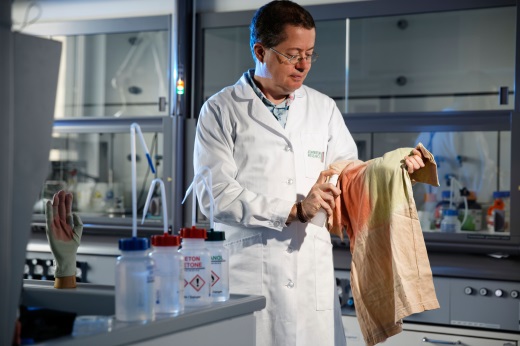
One target of the project is the development of coloured textiles, which can give information on the health of the person who wears the clothing.
The aim of the project SmartColourTextiles is to establish a technology for stable binding of indicator dyes and sensor pigments to fibres, yarns and fabrics. Thus, textiles and dressing materials can be equipped with specific sensor properties, which may find use in medical diagnostics. These materials are washable and stable against elevated temperatures, do not affect the wearing comfort and can be used reversibly.
MATERIALS offers outstanding international experience in the development of optical sensor devices including the preparation of indicator dyes and their stable attachment to polymer materials. The specific functional modification of textiles and non-wovens opens the possibility for developing new products in collaboration with the diagnostics and wound dressing industry as well as fibre and textile industry.
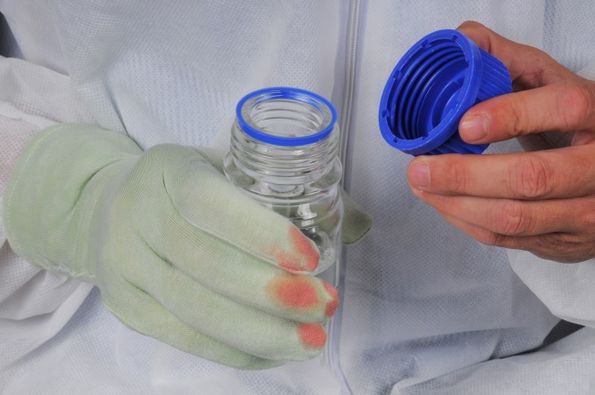
An indicator glove for working in laboratories warns from contact with strong acids or bases.
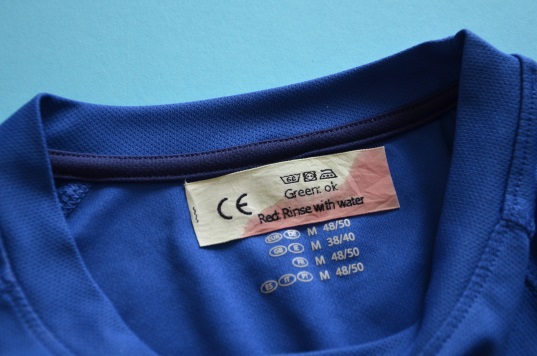
Indicator label indicating the presence of remaining detergents in textiles, that can cause skin irritations.
As part of the project, specific indicator dyes are developed in order to e.g.
- Detect metabolites of a bacterial infection in wounds (biogenic amines, hydrogen sulfide). A distinct colour change of the dressing material indicates when a therapy is required.
- Indicate if a washing solution for the skin of babies is too alkaline and will cause irritations. This is accomplished by a sensor textile (e.g. a washcloth) that shows a colour change from green to red upon increasing pH.
To exclude contamination by dyes, covalent binding of the indicator dyes to textiles and non-wovens is crucial. For the quantitative evaluation of the sensor fabrics, they may be combined with opto-electronic evaluation (fibre-optics, smart phones).
In addition to the synthesis of new functional dyes, the production process of textile sensors is researched as well:
- Yarns and textiles are dyed directly, as well as sensor pigments, which are mixed into the spinning solution prior to the spinning of the fibres
- In the case of textile materials that cannot be coloured covalently (e.g. polyester) sensor pigments are embedded into binder polymers and processed via screen or template printing
- Using the electro-spinning technology nano-fibres are prepared that exhibit extremely fast response and high sensitivity
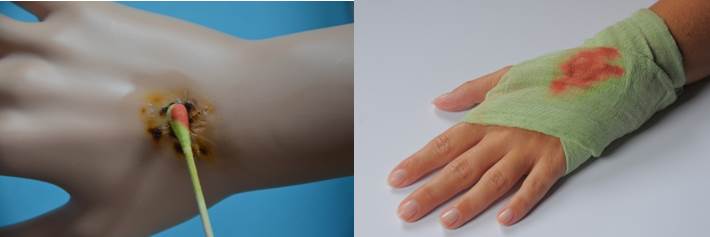
Indicator swabs and sensor wound dressings enable the detection of pH in wounds. The wound pH correlates with the wound healing and indicates the development of chronic wounds.
- Preparation of new indicator dyes for pH, Na+, Ca2+, Mg2+, amines and thiols and covalent immobilisation of indicator dyes to textiles and non-wovens
- Characterisation of sensor materials with respect to stability, colour change, sensitivity, reversibility, washability, sterilisability and toxicity
- Fabrication of sensor textiles for the detection of pH and electrolytes (Na+, Ca2+, Mg2+) in sweat
- Preparation of sensor wound dressings for the detection of pH, or metabolites of microbial contamination (amines, thiols), to enable the monitoring of wound healing
- Programming of smartphones/tablets for the quantitative evaluation of colour changes
- Development of a fibre-optic system for the detection of colour changes within textiles and non-wovens (in the case of no direct optical visibility)
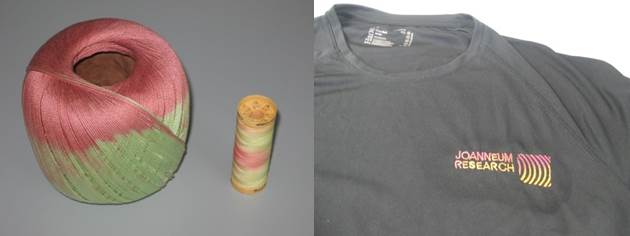
A coloured indicator yarn can be stitched onto polyester shirts.
- Development of smart textiles for manufacturers of textiles in the area of wellness, sports activities, Ambient Assisted Living
- Smart wound dressings/cotton swabs for patients with chronic wounds
- Indicator tests for diapers, cleaning towels, cosmetics
- Modification of textile fabrication processes towards sensor materials
- Adaptation of optical modules to textiles/non-wovens, e.g. optical chips, fibre-optics and smartphone technology
